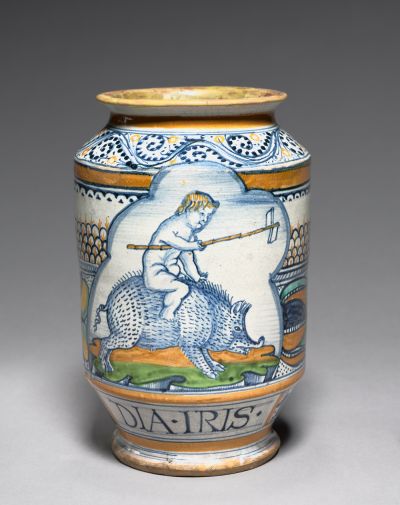L’albarello è un recipiente di maiolica anticamente usato nelle farmacie per contenere prodotti erboristici o preparati medicinali. In Italia il suo uso si diffuse in epoca medievale e rinascimentale. L’aspetto era quello di un vaso cilindrico di varie misure, decorato con ricche miniature o ornamenti pittorici, spesso più stretto nella parte centrale, con una ampia bocca ed una rientranza sotto l'orlo. Originariamente non aveva coperchio e veniva chiuso con carta pergamena fermata intorno al bordo con lo spago per evitare la contaminazione o la dispersione del contenuto. Un albarello particolarmente interessante tra quelli che fanno parte della collezione del Cleveland Museum of Art è stato realizzato a Siena intorno al 1510. La stravagante decorazione ritrae un putto che cavalca un cinghiale mentre tiene sotto il braccio una lancia con una girandola. L’iscrizione DIA / IRIS vicino alla base indica che l’albarello doveva contenere un derivato della pianta dell'iride.
The word “maiolica” refers to brightly-colored glazed earthenware ceramics for which Italy was famous during the Renaissance and remains so today. They were produced in various towns across Italy, often developing local styles and color preferences. They also came in a range of forms and sizes from plates to ewers (pitchers) and many others, to fill various domestic needs.
One particular form of maiolica vessel is known as the albarello, a cylindrical jar featuring a flared lip at the vessel’s mouth. Albarelli (plural) were essentially drug or pharmacy jars. They held medicinal herbs, spices, dyes, or ointments and sat on the shelves of apothecaries in Italy’s cities and towns. The flared lip on the vessel allowed the apothecary to cover the jar with a piece of parchment or cloth and tie it closed with a piece of string. This sealed the contents and kept them fresh. The parchment was often bleached white so that the contents of the jar could be written upon it. Sometimes the label was glazed directly onto the ceramic body of the vessel. The size of Renaissance albarelli can vary between 4 and 14 inches in height.
The Cleveland Museum of Art has several examples of these handsome ceramics in its collection. A particularly interesting albarello, made in Siena around 1510, features a whimsical picture of a putto, a naked child, riding on the back of a wild boar. He holds a lance with a pinwheel under his arm. An inscription near the base reads DIA / IRIS, indicating that it was intended to hold a derivative of the iris plant presumably believed to have medicinal benefits at the time. Such pharmacy jars served both functional and decorative purposes and represented both the status and wealth of the apothecary. For this reason, they were often elaborately decorated to the apothecary’s order and must have made an impressive display from the street.
There was a vast array of healthcare options in Renaissance Italy because the practice of medicine was not seen as an exclusively professional business. Anyone could do it. Physicians who had university degrees treated internal illnesses. Surgeons, who learned by apprenticeship, treated wounds, fractures, and external illnesses. Barber surgeons bled patients and pulled teeth and apothecaries made and sold medicines. Some apothecaries were licensed to practice their skill, many were not. Apothecary shops in Italy’s cities and towns were the primary venue for patients seeking medicinals, and, curiously, for artists seeking pigments. Indeed, Florentine artists were initially organized into a sub-group within the Guild of Doctors, Apothecaries, and Grocers established in 1293, one of the seven major guilds (Arti Maggiori), thus illustrating the close interaction between apothecaries, medicine and art.
Beginning in the Middle Ages, Florentine and Sienese apothecaries could be found as stand-alone shops in hospitals and monasteries. A common practice was for apothecaries to pay a salary to physicians for seeing patients within their shops with the resulting prescriptions being filled by the attending apothecary. In 1558, some 46 apothecaries were registered in Florence indicating the robust demand for their services. In conventual settings, both nuns and friars from a variety of orders were trained to prepare and dispense medicinals, mainly herbal, with most of the plants being grown in gardens belonging to the mother church. In Renaissance Italy, Italian nuns became a prominent source for medicinal needs, often dispensing to the public for profit. This profit they then used towards their charitable goals.
An example of an apothecary that evolved to become an outlet for medicinals and pigments was the speziera at the Dominican church and convent of Santa Maria Novella in Florence. Beginning in the 1300s as a small infirmary for the use of the friars living there, the apothecary was later expanded to offer spices, pigments and medicinals to the Florentine public. Though it closed for about 20 years in the late 1500s, it reopened in 1612 under the direction of Fra’Angiolo Marchissi. An herbal specialist was hired to prepare medicines for the friars and greater Florentine community. Today, the site of the original apothecary houses the Officina Profumo-Farmaceutica di Santa Maria Novella, selling soaps and perfumes. The public can visit the monastic herbal preparation rooms that contain apparati and pharmacy jars, like the Cleveland example, dating from the 1500s.
That so many of these beautiful pharmaceutical ceramics have survived in many museums across Europe and the U.S., testifies to the brisk demand for such vessels from apothecaries and the resulting business for ceramic artists across Italy.



